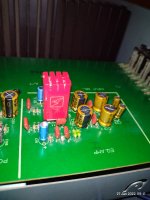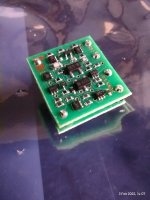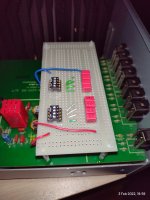More info regarding the Burson. I've done a noise floor test which shows this has the lowest so far of the opamps tested.
This can only be a good thing.
To my ears this opamp provides the best balance, clarity, soundstage, depth & musicality so far, albeit at a cost.
It will be for you to decide whether this is worth the outlay in your application.
I'm not convinced that running this in will make any difference but I will give it a go anyway.
When I receive the sparkoslabs unit I will do a back to back test.
This can only be a good thing.
To my ears this opamp provides the best balance, clarity, soundstage, depth & musicality so far, albeit at a cost.
It will be for you to decide whether this is worth the outlay in your application.
I'm not convinced that running this in will make any difference but I will give it a go anyway.
When I receive the sparkoslabs unit I will do a back to back test.
Attachments
Decided to add a switchable capacitance board to the phono input, in order to be able to fine tune for different cartridges, see below.
Also a big thanks again to Andrew at Sparkoslabs for supplying an SS3602 for comparison, see below.
Still trialing the Burson V6 so will get to the SS3602 shortly.
Also a big thanks again to Andrew at Sparkoslabs for supplying an SS3602 for comparison, see below.
Still trialing the Burson V6 so will get to the SS3602 shortly.
Attachments
Right Here Goes.
I've set the switched capactor mod to the same value as was fitted to the original EQ circuit as to make sure I was doing a like for like comparison.
The Burson V6 vivid, where do I start.
The improvements over the previous opamps are quite remarkable in every sense.
The detail that is revealed is quite astounding, especially in quieter tracks, probably down to the lower noise floor.
It appears to be far more musical in its presentation & slightly on the warm side which is how I prefer it.
It takes a good half an hour for the sound to settle into its stride which I guess is down to the components reaching optimal temperature.
Aa a side note, I did not notice any change from the burn in process.
The bass is very clean & punchy.
Mids are full & engaging.
Treble is clear & sharp without being over taxing.
The soundstage is broad & full.
It provides increased depth & dynamics therefore making the music more involving.
So in conclusion, this is a cracking modification even with its fairly high cost in comparison with IC opamps.
It definitely requires a decent source to provide it with the goods to work with.
At the end of the test I have done a bit of testing by changing the load capacitance seen by the cartridge.
The Shure can sometimes be a little bright on some tracks, by lowering the capacitance to the lowest value of 33pF in the amp.
Testing the leads & tonearm cabling which came to 88pF, this gave a total of 121pF. This appeared to cure the over brightness on those tracks.
I have an Audio Technica AT130E cart to try, but I'm just waiting for a new stylus to arrive.
I will return the amp capacitance to 100pF for the Sparkoslabs tests, which I will do next.
I've set the switched capactor mod to the same value as was fitted to the original EQ circuit as to make sure I was doing a like for like comparison.
The Burson V6 vivid, where do I start.
The improvements over the previous opamps are quite remarkable in every sense.
The detail that is revealed is quite astounding, especially in quieter tracks, probably down to the lower noise floor.
It appears to be far more musical in its presentation & slightly on the warm side which is how I prefer it.
It takes a good half an hour for the sound to settle into its stride which I guess is down to the components reaching optimal temperature.
Aa a side note, I did not notice any change from the burn in process.
The bass is very clean & punchy.
Mids are full & engaging.
Treble is clear & sharp without being over taxing.
The soundstage is broad & full.
It provides increased depth & dynamics therefore making the music more involving.
So in conclusion, this is a cracking modification even with its fairly high cost in comparison with IC opamps.
It definitely requires a decent source to provide it with the goods to work with.
At the end of the test I have done a bit of testing by changing the load capacitance seen by the cartridge.
The Shure can sometimes be a little bright on some tracks, by lowering the capacitance to the lowest value of 33pF in the amp.
Testing the leads & tonearm cabling which came to 88pF, this gave a total of 121pF. This appeared to cure the over brightness on those tracks.
I have an Audio Technica AT130E cart to try, but I'm just waiting for a new stylus to arrive.
I will return the amp capacitance to 100pF for the Sparkoslabs tests, which I will do next.
There's no burn-in period unless you've used some decades old electrolytics. Semiconductors don't have burn-in.I am going through a burn in period as that seems what most users do, before I do some listening tests.
That's not the point, it was that distortion will be unnecessarily high at low frequencies due to less linearizing feedback than you'd expect from a good opamp. A lack of level at low frequencies would indeed be truly dismal performance for an opamp (which are fundamentally DC amplifiers).Initial listening reveals a very balanced sound not lacking in low frequencies.
Firstly in response to the comment above.
Using RMAA software & measuring the THD of the Burson from the pre-amp out.
The info was that the THD was only 0.08% across the whole spectrum.
Therefore there isnt the high distortion suggested above.
Using RMAA software & measuring the THD of the Burson from the pre-amp out.
The info was that the THD was only 0.08% across the whole spectrum.
Therefore there isnt the high distortion suggested above.
Moving on to the Sparkoslabs SS3602.
No issues with fitment, plenty of clearance.
I started with a few tests using Audacity.
The results were rather odd. without any drive into the phono input.
The base noise levels were rather high, with some strange high frequency peaks. see attached noise trace.
Just to check that it was down to the op-amp I swapped back to the Burson & all was clear, so must be down to the SS3602.
The next test was to do the response sweep.
Again the results were a bit odd. see attached.
The low frequency response tapered off very rapidly. Not what I expected!
Again I swapped back to the Burson & all returned to what was expected.
Not sure whats going on here?
Now down to listening tests.
I thought I try a peak hold frequency test on the same track using both Burson & Sparkoslabs op-amps.
The response is very similar. see attached.
So not the low frequency drop off as suggested by the Audacity test.
Maybe due to the different load seen by the PC output opposed to the cartridge output.
After a few hours of listening I have come to the conclusion that the differences between the Burson & Sparkoslabs is very minimal but noticable.
IMO the SS3602 appears to be a little more forward in its presentation of the midrange, & the Burson has a slightly stronger base prescence, Thats about it.
I checked the base noise levels with the turntable connected & both Burson & Sparkoslabs were virtually identical.
In conclusion both the SS3602 & the V6 Vivid are really good options to improve the standard IC opamps in this application.
I cannot choose between the two units as to which I prefer.
I have a couple more cartridges to try to see if I can find anything that would improve the overall sound.
These are an Audio Technica AT130e & an Ortofon OM20.
No issues with fitment, plenty of clearance.
I started with a few tests using Audacity.
The results were rather odd. without any drive into the phono input.
The base noise levels were rather high, with some strange high frequency peaks. see attached noise trace.
Just to check that it was down to the op-amp I swapped back to the Burson & all was clear, so must be down to the SS3602.
The next test was to do the response sweep.
Again the results were a bit odd. see attached.
The low frequency response tapered off very rapidly. Not what I expected!
Again I swapped back to the Burson & all returned to what was expected.
Not sure whats going on here?
Now down to listening tests.
I thought I try a peak hold frequency test on the same track using both Burson & Sparkoslabs op-amps.
The response is very similar. see attached.
So not the low frequency drop off as suggested by the Audacity test.
Maybe due to the different load seen by the PC output opposed to the cartridge output.
After a few hours of listening I have come to the conclusion that the differences between the Burson & Sparkoslabs is very minimal but noticable.
IMO the SS3602 appears to be a little more forward in its presentation of the midrange, & the Burson has a slightly stronger base prescence, Thats about it.
I checked the base noise levels with the turntable connected & both Burson & Sparkoslabs were virtually identical.
In conclusion both the SS3602 & the V6 Vivid are really good options to improve the standard IC opamps in this application.
I cannot choose between the two units as to which I prefer.
I have a couple more cartridges to try to see if I can find anything that would improve the overall sound.
These are an Audio Technica AT130e & an Ortofon OM20.
Attachments
- Home
- Amplifiers
- Solid State
- Kenwood KA-3020SE re-cap & phono opamp upgrade


